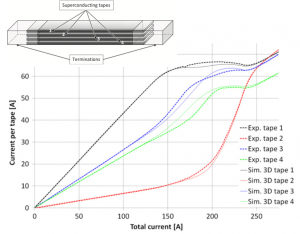The models presented here are used to simulate termination resistances which are largely responsible for the uneven distribution of currents in superconducting cables [1]. For this purpose, four different models are presented. The first is a 0D stationary model, where time enters as a parameter driving the net current in the cable. Being the simplest and fastest, it can be used to obtain a qualitative estimate of the current distributions (described in [2]). The second model, also stationary, is a 2D approach that considers both the actual cross section of the cable, and the dependence of the critical current density with respect to the magnetic field (described in [3]). The third model, also in 2D, is a quasi-static approach where an additional term is added to the electric field to take into account the voltage drop due to termination resistances (described in [2]). The fourth model, also quasi-static, is a 3D approach. Using two non-connected domains, it simulates both the termination resistances and the superconducting cable to calculate the current share in the cable’s strands (described in [2]).
Reference articles:
[1] Takayasu et al. 2012 Supercond. Sci. Technol. 25 014011
[2] Zermeno et al. 2014 Supercond. Sci. Technol. 27 124013
[3] Zermeno et al. 2015 Supercond. Sci. Technol. 28 085004

Comments are closed.